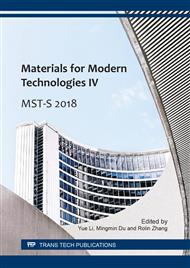[1]
M. Khraisheh, Y. Aldegs, W. McMinn, Remediation of wastewater containing heavy metals using raw and modified diatomite, Chem. Eng. J., 99 (2004) 177-184.
DOI: 10.1016/j.cej.2003.11.029
Google Scholar
[2]
H. Beheshti, M. Irani, Removal of lead(II) ions from aqueous solutions using diatomite nanoparticles, Desalination and Water Treatment, 57 (2015) 18799-18805.
DOI: 10.1080/19443994.2015.1095683
Google Scholar
[3]
M. Irani, M. Amjadi, M.A. Mousavian, Comparative study of lead sorption onto natural perlite, dolomite and diatomite, Chem. Eng. J., 178 (2011) 317-323.
DOI: 10.1016/j.cej.2011.10.011
Google Scholar
[4]
Z. Jia, X. Duan, P. Qin, W. Zhang, W. Wang, C. Yang, H. Sun, S. Wang, L.C. Zhang, Disordered atomic packing structure of metallic glass: toward ultrafast hydroxyl radicals production rate and strong electron transfer ability in catalytic performance, Adv. Funct. Mater., 27 (2017).
DOI: 10.1002/adfm.201702258
Google Scholar
[5]
S.X. Liang, Z. Jia, W.C. Zhang, W.M. Wang, L.C. Zhang, Rapid malachite green degradation using Fe73.5Si13.5B9Cu1Nb3 metallic glass for activation of persulfate under UV–Vis light, Materials & Design, 119 (2017) 244-253.
DOI: 10.1016/j.matdes.2017.01.039
Google Scholar
[6]
Z. Jia, W.C. Zhang, W.M. Wang, D. Habibi, L.C. Zhang, Amorphous Fe 78 Si 9 B 13 alloy: An efficient and reusable photo-enhanced Fenton-like catalyst in degradation of cibacron brilliant red 3B-A dye under UV–vis light, Applied Catalysis B: Environmental, 192 (2016).
DOI: 10.1016/j.apcatb.2016.03.048
Google Scholar
[7]
Y. Al-Degs, M. Khraisheh, M. Tutunji, Sorption of lead ions on diatomite and manganese oxides modified diatomite, Water Res., 35 (2001) 3724-3728.
DOI: 10.1016/s0043-1354(01)00071-9
Google Scholar
[8]
R. Liu, Y. Lu, X. Shen, Q. Liang, Q. Wang, Arsenic (V) adsorption from aqueous solution on magnetic Fe0. 2 (Co20Ni80) 0.8 alloy porous microfibers, Water, Air, Soil Pollut., 223 (2012) 5365-5373.
DOI: 10.1007/s11270-012-1286-2
Google Scholar
[9]
B. Hameed, J. Salman, A. Ahmad, Adsorption isotherm and kinetic modeling of 2, 4-D pesticide on activated carbon derived from date stones, J. Hazard. Mater., 163 (2009) 121-126.
DOI: 10.1016/j.jhazmat.2008.06.069
Google Scholar
[10]
M. Khraisheh, M. Al-Ghouti, S. Allen, M. Ahmad, Effect of OH and silanol groups in the removal of dyes from aqueous solution using diatomite, Water Research, 39 (2005) 922-932.
DOI: 10.1016/j.watres.2004.12.008
Google Scholar
[11]
N. Caliskan, E. Sogut, C. Saka, Y. Yardim, Z. Senturk, The Natural Diatomite from Caldiran-Van (Turkey): Electroanalytical Application to Antimigraine Compound Naratriptan at Modified Carbon Paste Electrode, Combinatorial Chemistry & High Throughput Screening, 13 (2010).
DOI: 10.2174/138620710791920356
Google Scholar
[12]
B. Bahramian, F.D. Ardejani, V. Mirkhani, K. Badii, Diatomite-supported manganese Schiff base: An efficient catalyst for oxidation of hydrocarbons, Applied Catalysis A: General, 345 (2008) 97-103.
DOI: 10.1016/j.apcata.2008.04.028
Google Scholar
[13]
M. Safa, M. Larouci, B. Meddah, P. Valemens, The sorption of lead, cadmium, copper and zinc ions from aqueous solutions on a raw diatomite from Algeria, Water Sci. Technol., 65 (2012) 1729-1737.
DOI: 10.2166/wst.2012.183
Google Scholar
[14]
J.U.K. Oubagaranadin, Z. Murthy, Adsorption of divalent lead on a montmorillonite− illite type of clay, Industrial & Engineering Chemistry Research, 48 (2009) 10627-10636.
DOI: 10.1021/ie9005047
Google Scholar
[15]
H. Koyuncu, A.R. Kul, N. Yıldız, A. Çalımlı, H. Ceylan, Equilibrium and kinetic studies for the sorption of 3-methoxybenzaldehyde on activated kaolinites, J. Hazard. Mater., 141 (2007) 128-139.
DOI: 10.1016/j.jhazmat.2006.06.101
Google Scholar
[16]
Z. Jia, S. Liang, W. Zhang, W. Wang, C. Yang, L. Zhang, Heterogeneous photo Fenton-like degradation of cibacron brilliant red 3B-A dye using amorphous Fe 78 Si 9 B 13 and Fe 73.5 Si 13.5 B 9 Cu 1 Nb 3 alloys: The influence of adsorption, Journal of the Taiwan Institute of Chemical Engineers, 71 (2017).
DOI: 10.1016/j.jtice.2016.11.021
Google Scholar
[17]
K.G. Bhattacharyya, A. Sharma, Kinetics and thermodynamics of methylene blue adsorption on neem (Azadirachta indica) leaf powder, Dyes and pigments, 65 (2005) 51-59.
DOI: 10.1016/j.dyepig.2004.06.016
Google Scholar


